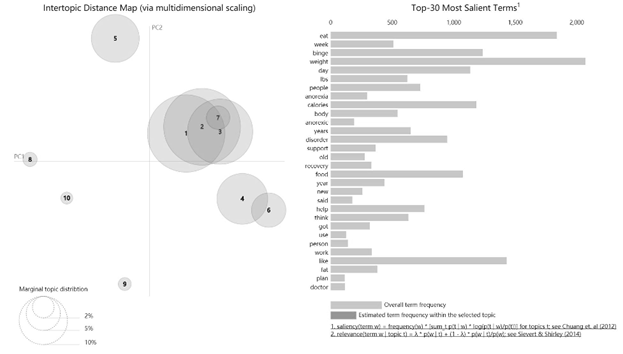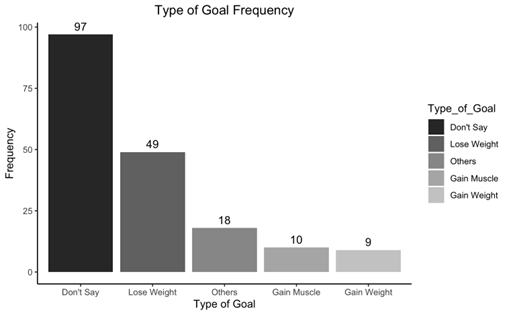Understanding User Needs on
a Diet and Fitness App
We’ve learned that even apps unrelated to specific mental health support must design with users’ mental health concerns in mind. Our research investigated discourse surrounding eating disorders on a diet and fitness app in combination with user goals for using the app.
Role: Assistant Researcher. 2020-2021. Mental Health in Design Lab.
Skills: Excel, behavioral coding, topic modeling, APA format and academic writing.
Question: What do users who discuss eating disorders need to support their health goals?
While digital interventions have the potential to be a lifeline for people struggling with mental health conditions, they also have the potential to harm them. By designing to support users’ mental health, we open our products to all users. By understanding the needs of users struggling with their mental health, we can create better design.
While there has been research that investigates how users discuss diet and fitness apps in eating disorder communities, little research has been done into how users discuss eating disorders in diet and fitness communities. We aimed to bridge that gap. Our project looked specifically at the needs of users who discussed eating disorders on a diet and fitness app to understand how we can best design to support their mental health needs.
Note: We do not name the specific app this research was conducted on due to concern for user privacy.
Goal: Understand and accentuate the needs of users who have experience with eating disorders.
How did we do it?
We used exploratory topic modeling and manual coding to analyze user-created threads posted in the social forum of a diet and fitness app. 1,941 threads were captured using a keyword search for eating disorder terms (“eating disorder,” “anorexia/anorexic,””binge eating disorder,” “bulimia/bulimic” and “EDNOS”).
Topic modeling
We used Latent Dirichlet Allocation (LDA) topic modeling to identify topics of discussion. 10 topics were identified, consisting of 30 words that most commonly appeared together.
Manual coding
We took a random sample of 50 posts from each keyword. Only posts where the poster self-disclosed about a mental health issue or abnormal emotional response were used, leaving us with a sample of 169 posts. An inductive approach was used to create a codebook for these posts, focusing on health goals and attitudes.
What did we learn?
Topic Modeling
We identified 10 topics in our dataset.
Personal narratives and disclosure
Users’ bodies and exercise
Family
Meals and food
User feelings towards their body
User experiences with bingeing
Information (i.e. further reading, research)
Weight loss journeys
Requests for support to stop bingeing
Anorexia recovery and medicalization
Topic modeling of the most relevant terms in our dataset.
Among all eating disorder categories, terms such as “calories,” “weight,” or “lb(s)” were common. Terms such as “support” or “help” were among the top words for each category. However, there were a few important differences between categories.
Socializing
“Friends” was common exclusively for the anorexia and eating disorder keyword groups. This indicates that these groups may be turning to diet and fitness apps for socialization at a higher rate than users concerned with other EDs.
Food and Nutrition
The binge eating disorder category was the only category where top words included food-related terms such as “protein” or “chocolate.” This finding indicates that users struggling with binge eating disorder may use diet and fitness apps to understand or treat their diet, specifically.
Manual Coding
We found quite a bit of variance among the goals of users in our sample.
User goals vary and exceed the limits of the app
Our coding primarily sought to identify the health goals of users who have experienced an eating disorder. Users in our sample largely did not mention a specific health goal. Of those that did, losing weight was most common, followed by other health goals unrelated to their weight or fitness, then gaining muscle. Wishing to gain weight was the least common goal.
Notably, users had many goals that were not supported by the app’s design. Other health goals mentioned by users included:
Improving digestion/metabolism
Regaining their period
Train for a sporting event
Obtain a specific body shape
Many more!
Users, especially users who have experienced an eating disorder, are unable to use the app to support their health goals. Possible redesigns should allow users to track these goals, even if direct developer support is not offered.
The frequency of each goal within our sample.
The distribution of goal types among each category within our sample
Goal type varies by disorder-category
We also found that health goals varied by eating disorder keyword group. For example, most users in the binge eating disorder keyword group did not mention a specific health goal. By contrast, users in the anorexia keyword group had a much more even distribution of health goals and primarily wished to lose weight.
Users model “healthy” or “unhealthy” patterns of weight loss
Finally, users understood their eating disorders as “unhealthy” methods of weight loss. Many turned to diet and fitness apps to promote “healthy” weight loss.
However, user response to app-promoted weight loss was mixed. Some users expressed concern about relapse fueled by features of the app.
“I find [the app] so helpful, but also it's way too easy to fall back into the controlling anorexic mindset.”
Overall, users largely wished to lose weight in a “healthy” way, and turned to the diet and fitness app’s community to fulfill this goal. By attempting to reach and support this audience, diet and fitness apps can provide a more positive environment for all their users, while improving their efficacy as a health app.
“I want to lose the weight the healthy way… I don’t want to become obsessed with calories… Calorie counting works but it fuels my eating disorder..”
These findings indicate that users “walk the line” between relapse and recovery on diet and fitness apps. The question that we as designers must must answer is:
“How can we encourage recovery for vulnerable users?”
Elizabeth V. Eikey, Oliver Golden, Zhuoxi Chen and Qiuer Chen, ‘Chapter 9: Eating Disorder Discourse in a Diet and Fitness App Community: Understanding User Needs Through Exploratory Mixed Methods’ in: Eating Disorders in Public Discourse: Exploring Media Representations and Lived Experiences. University of Exeter Press (2023). © Elizabeth V. Eikey et al. DOI: 10.47788/DCZA4511



